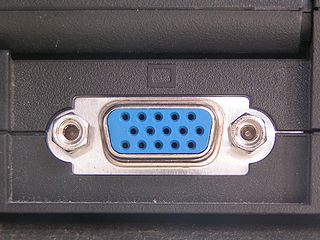Related Research Articles
Advanced power management (APM) is a technical standard for power management developed by Intel and Microsoft and released in 1992 which enables an operating system running an IBM-compatible personal computer to work with the BIOS to achieve power management.

A computer monitor is an output device that displays information in pictorial or textual form. A discrete monitor comprises a visual display, support electronics, power supply, housing, electrical connectors, and external user controls.

Digital Visual Interface (DVI) is a video display interface developed by the Digital Display Working Group (DDWG). The digital interface is used to connect a video source, such as a video display controller, to a display device, such as a computer monitor. It was developed with the intention of creating an industry standard for the transfer of uncompressed digital video content.

VESA, formally known as Video Electronics Standards Association, is an American technical standards organization for computer display standards. The organization was incorporated in California in July 1989 and has its office in San Jose. It claims a membership of over 300 companies.
VESA BIOS Extensions (VBE) is a VESA standard, currently at version 3, that defines the interface that can be used by software to access compliant video boards at high resolutions and bit depths. This is opposed to the "traditional" INT 10h BIOS calls, which are limited to resolutions of 640×480 pixels with 16 colour (4-bit) depth or less. VBE is made available through the video card's BIOS, which installs during boot up some interrupt vectors that point to itself.
Gamma correction or gamma is a nonlinear operation used to encode and decode luminance or tristimulus values in video or still image systems. Gamma correction is, in the simplest cases, defined by the following power-law expression:

Video Graphics Array (VGA) is a video display controller and accompanying de facto graphics standard, first introduced with the IBM PS/2 line of computers in 1987, which became ubiquitous in the IBM PC compatible industry within three years. The term can now refer to the computer display standard, the 15-pin D-subminiature VGA connector, or the 640 × 480 resolution characteristic of the VGA hardware.

SCART is a French-originated standard and associated 21-pin connector for connecting audio-visual (AV) equipment. The name SCART comes from Syndicat des Constructeurs d'Appareils Radiorécepteurs et Téléviseurs, "Radio and Television Receiver Manufacturers' Association", the French organisation that created the connector in the mid-1970s. The related European standard EN 50049 has then been refined and published in 1978 by CENELEC, calling it péritelevision, but it is commonly called by the abbreviation péritel in French.
The Display Data Channel, or DDC, is a collection of protocols for digital communication between a computer display and a graphics adapter that enable the display to communicate its supported display modes to the adapter and that enable the computer host to adjust monitor parameters, such as brightness and contrast.

High-Definition Multimedia Interface (HDMI) is a proprietary audio/video interface for transmitting uncompressed video data and compressed or uncompressed digital audio data from an HDMI-compliant source device, such as a display controller, to a compatible computer monitor, video projector, digital television, or digital audio device. HDMI is a digital replacement for analog video standards.

The Video Graphics Array (VGA) connector is a standard connector used for computer video output. Originating with the 1987 IBM PS/2 and its VGA graphics system, the 15-pin connector went on to become ubiquitous on PCs, as well as many monitors, projectors and high-definition television sets.

Sleep mode is a low power mode for electronic devices such as computers, televisions, and remote controlled devices. These modes save significantly on electrical consumption compared to leaving a device fully on and, upon resume, allow the user to avoid having to reissue instructions or to wait for a machine to boot. Many devices signify this power mode with a pulsed or red colored LED power light.

DisplayPort (DP) is a proprietary digital display interface developed by a consortium of PC and chip manufacturers and standardized by the Video Electronics Standards Association (VESA). It is primarily used to connect a video source to a display device such as a computer monitor. It can also carry audio, USB, and other forms of data.
Standby power, also called vampire power, vampire draw, phantom load, ghost load or leaking electricity refers to the way electric power is consumed by electronic and electrical appliances while they are switched off or in standby mode. This only occurs because some devices claimed to be "switched off" on the electronic interface, but are in a different state. Switching off at the plug, or disconnecting from the power point, can solve the problem of standby power completely. In fact, switching off at the power point is effective enough, there is no need to disconnect all devices from the power point. Some such devices offer remote controls and digital clock features to the user, while other devices, such as power adapters for disconnected electronic devices, consume power without offering any features. All of the above examples, such as the remote control, digital clock functions and—in the case of adapters, no-load power—are switched off just by switching off at the power point. However, for some devices with built-in internal battery, such as a phone, the standby functions can be stopped by removing the battery instead.
Coordinated Video Timings is a standard by VESA which defines the timings of the component video signal. Initially intended for use by computer monitors and video cards, the standard made its way into consumer televisions.
The One Watt Initiative is an energy-saving initiative by the International Energy Agency (IEA) to reduce standby power-use by any appliance to no more than one watt in 2010, and 0.5 watts in 2013, which has given rise to regulations in many countries and regions.
A multiple-sync (multisync) monitor, also known as a multiscan or multimode monitor, is a raster-scan analog video monitor that can properly synchronise with multiple horizontal and vertical scan rates. In contrast, fixed frequency monitors can only synchronise with a specific set of scan rates. They are generally used for computer displays, but sometimes for television, and the terminology is mostly applied to CRT displays although the concept applies to other technologies.
Generalized Timing Formula is a standard by VESA which defines exact parameters of the component video signal for analogue VGA display interface.

USB-C, or USB Type-C, is a 24-pin connector that supersedes previous USB connectors and can carry audio, video and other data, e.g., to drive multiple displays or to store a backup to an external drive. It can also provide and receive power, such as powering a laptop or a mobile phone. It is applied not only by USB technology, but also by other protocols, including Thunderbolt, PCIe, HDMI, DisplayPort, and others. It is extensible to support future standards.
Variable refresh rate (VRR) refers to a dynamic display that can continuously and seamlessly change its refresh rate without user input. A display supporting a variable refresh rate usually supports a specific range of refresh rates. This is called the VRR range. The refresh rate can continuously vary seamlessly anywhere within this range.
References
- ↑ "PC User Guide: Chapter 8". Archived from the original on 2011-11-22. Retrieved 2007-04-16.
- ↑ On a Targa TM 3820 PNLD monitor.
- ↑ Myers, Bob. "Implications of power saving modes". repairfaq.org. Samuel M. Goldwasser. Retrieved 9 January 2022.
Energy Star and similar power-saving certifications generally don't specify what is done inside the monitor to achieve the power reduction, just the maximum power dissipation in the "reduced power" state(s).
- ↑ "DPMSSetTimeouts(3)" . Retrieved 9 January 2022.
- ↑ "XFCE Power Manager - Preferences" . Retrieved 9 January 2022.
- ↑ "Eizo FX D7, T68, TX D7, F67 User Manual". manualsdump.com. p. 31. Retrieved 9 January 2022. - implementation example.